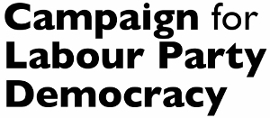

 |
 | ||||||||||||||||||
April 2019
Please find below the motion that the Campaign for Labour Party Democracy (CLPD) is asking CLPs to prioritise for sending to this year's Labour Party Conference.
It is important for the future of the Labour Party that Conference asks the NEC to look again at the issue of leadership elections.
The motion that CLPD is asking CLPs to consider send to Labour Conference 2019 is:-
Conference motion - For a democratic choice in Labour leadership elections
Conference notes:
Conference believes:
Conference notes the Democracy Review contained a proposal in line with this motion.
Conference therefore asks the NEC to bring forward to 2020 Conference a range of options, including the Democracy Review proposal, to widen the range of potential candidates.
Labour leadership election nomination thresholds rules - a short briefing
Under current Labour Party rules (in 2019), when there is next a vacancy for Leader there is no guarantee that a candidate with a progressive agenda, similar to the current leadership, would be able to stand for the post of Leader. MPs have, in effect, a veto over who can stand for Leader.
The recommendation put forward by the 2018 Democracy Review - which would have reduced the threshold of MPs/MEPs nominations to five per cent - was not voted on at the 2018 Conference.
Under the current rules, any potential candidate requires nominations from at least ten per cent of MPs plus MEPs, in order to secure a place on the ballot paper. That would allow MPs and MEPs to block a popular progressive candidate from standing in a leadership election.
The ten per cent threshold of MPs/MEPs would currently mean 26 nominations from MPs/MEPs, far more than the number that supported Jeremy Corbyn in 2015, when only approximately 15 MPs voted for him to be Leader. Jeremy Corbyn got on the ballot paper that year because right wing Labour MPs 'lent' him their nominations anticipating his defeat - they do not intend to repeat this 'mistake' in future.
The rules for leadership elections have been altered many times over the past 40 years. The main changes to the nominations stage have been as follows:
1) Prior to 1980s the nomination threshold was just two MPs (Nomination and Seconder). Then, till 1988, the threshold was 5% of MPs. In 1988 it was raised to 10% of MPs.
2) By the time of the 2015 leadership election the nomination threshold for when there is a vacancy had risen to 15% of MPs. Then at the 2017 Labour Conference this threshold was lowered from 15% MPs and MEPs to 10%.
3) In 2018, the Democracy Review put forward a proposal which could be loosely described as '10% PLP/EPLP OR 10% CLPs plus 5% PLP/EPLP OR 10% Affiliates plus 5% PLP/EPLP'. The proposal was not agreed at Labour's NEC on 22 September 2018 and an alternative formula (which could be described as '10% PLP/EPLP plus EITHER 5% CLPs OR 5% Affiliates') was agreed by the NEC and put to the 2018 Conference. This latter proposal was agreed by the Conference - however 69.16% of the CLP vote was cast against it.
4) The current rules ('10% PLP/EPLP plus EITHER 5% CLPs OR 5% Affiliates') require a potential candidate to secure the nomination of ten per cent of MPs plus MEPs, plus either five per cent of CLPs or five per cent of affiliates (the precise formula being: at least 3 affiliates - at least 2 of which shall be trade union affiliates - comprising 5 per cent of affiliated membership).
Back to home page